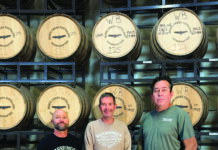By Karen Lindell
Satya Twena’s halo hats go through hell to become heavenly.
Most hats begin as a piece of felt — not the stuff used to make kindergarten crafts, but a super-strong fabric that is essentially the compressed, matted and fiercely interlocking hairs of an animal such as a beaver, rabbit or sheep. Machines and human beings vacuum, heat, stretch, roll, press and manipulate the hairs until they become a cone of felt that serves as the bare body of a hat.
The cone-shaped felt is then shipped to the milliner — in this case, Twena and the artisans who work in her Ojai atelier. They use skilled hands and a carved wooden form called a block, plus steam and an iron, to knead, pummel and smooth it into a desired shape. They block the hats by hand, not by using machines the way many hat factories do.
For Twena, the details come next: intricate lines of embroidery to create what truly looks like a halo on the brim of the hat, along with other sewn personal details, gathered from talking to the custom-made hat’s owner, including symbols, constellations and a mantra or personal message inside.
Hat maker, artist, sculptor.
Twena considers herself all three.
“We put so much intention, love, power and magic into it,” she said. “It’s not just a hat — each individual thing is a piece of art, a masterpiece. A hat is a canvas, and it has a way of being what it wants to be.”
Celebrities including Lady Gaga, Oprah Winfrey (on two of her magazine covers), Anne Hathaway and Reese Witherspoon all wear her hats. But so do non-famous people, and Twena infuses each hat with the individual wearer’s story and intentions.
From athletics to art
Twena’s own story of how she came to love and master the art, craft and spirit of hat-making begins when she was growing up in Newport Beach.
Her parents, she said, “were Jewish Buddhists from California, and gave me a Sanskrit name (Satya) that means truth.” Hats were a common piece of clothing in their household.
“My parents were putting me in hats as long as I can remember,” Twena said. “I had an aunt who was a well-known fashion designer in L.A. in the ‘80s. I was dressed to the nines in gorgeous outfits, including turbans and headbands and headpieces.”
For a period during high school, when she was a stand-out soccer athlete, and during her years at Wellesley College in Massachusetts majoring in psychology and women’s studies, she didn’t think much about hats. After graduating from college, she studied interior design at the Parsons School in Manhattan, and landed a job at the high-end home design firm Studio Sofield in New York City. She then started taking art and fashion classes at the Fashion Institute of Technology (FIT).
“I had been a pretty recognized athlete, since the age of 10 until my 20s, and had been running and doing agility activities,” she said. “In New York, I was not doing a lot of athletics, and had a lot of anxiety.”
Her mother, Ojai artist Pamela Grau, recommended art classes to offset any trapped nervous energy, so she took knitting, crocheting and millinery courses at FIT in the evenings.
“The millinery class wasn’t anything like I do now,” she said. “It was hats that were more like berets. It made me realize I wanted to sew, so I took a sewing class.”
In 2010, soon after taking the millinery course, Twena learned that her mother had cancer. When her mom’s hair started to fall out from chemotherapy, Twena wanted to create something warm, soft and protective for her head. So Twena made her a hat — a wool one with a ribbon band. She brought it to life in her apartment using a Jiffy steamer and kitchen oven to mold and bake it into shape.
Grau, now healthy and in remission from cancer, recalled her daughter’s gesture: “I was very sick at the time, but I was really thrilled. It was a lovely hat. It’s hard to go back to that time, but it was so wonderful she would do that for me.”
#SaveManHATtan
Twena enjoyed the experience so much that she started a hat company in her apartment, then opened a studio in Manhattan’s garment district, where she continued to make custom hats by hand.
Orders kept coming in, and a friend told her about Makins Hats, a 5,000-square-foot vintage hat-making factory, also in the garment district, that had been creating hats by hand since 1974. For large orders, Twena started working with the factory, and when Makins closed abruptly in 2013, she decided to buy the company and all its equipment. In the process, she helped save one of New York City’s last hat-making factories.
By then married, she got financial help from family and friends, and created a Kickstarter crowdfunding campaign to raise money to hire back the rest of the factory’s employees.
People who pledged Kickstarter funds got rewards like a “How to Wear a Hat” PDF ($1), a vintage hat bow pin ($5), a hat from her collection ($97), or a factory tour and a chance to design a hat ($450).
Twena wanted to raise $75,000, and ended up with 1,379 backers pledging $171,966.
The campaign’s hashtag was “#SaveManHATtan.”
The Kickstarter campaign, and growing appreciation of Twena’s hat handiwork, garnered a lot of press attention, including in the Wall Street Journal, Glamour magazine and on the Today show.
Twena credits having a great story to tell — “last hat factory in New York City closing; young entrepreneurial female wants to show that handcrafted things still matter” — and strong marketing for getting the word out.
In particular, she found success with support from Instagram influencers, including Stacy London, co-host of the TLC reality show What Not to Wear; and Kelly Framel of “The Glamourai” fashion blog.
Twena began selling her hats at Nordstrom and other high-end department stores. Celebrities and models wore her hats in photo shoots or just out and about. The Neiman Marcus store at Hudson Yards carried her hats until it closed in 2020.
“Personal pieces of art”
So how did a New York fashion maven end up in Ojai?
Twena is married to chef/creative consultant Jeffrey Zurofsky. When she became pregnant with their first child in 2016, she decided to have the baby in California, where she could spend time with her mother, who had moved to Ojai.
“I never thought I was coming back” to SoCal, she said. “I considered myself a displaced Parisian or European. I love the European lifestyle, and Ojai has a similar feel to Tuscany or the Loire Valley outside of Paris.”
Wanting to remain close to her mom, and inspired by Ojai’s slower pace and aura, she stayed in Ojai instead of returning to New York, sold the Manhattan factory, and now makes hats out of her home studio.
Her hats are still sold in New York City at ABC Carpet & Home, but they aren’t available at retail locations in California. Instead, customers contact her directly to purchase and make a hat.
“I’m now focusing on personal pieces of art, and not doing much wholesale these days,” Twena said. “My gift is talking to someone, finding out what they want — not making hats just to sell hats.” What makes a great hat, she said, is “the symbol and meaning behind how and why the hat was made.”
Susan Bruce of Ventura has worked with Twena in her Ojai studio for two years. She applied for the job when Twena put an ad online seeking people who could do basic hand-sewing.
Creating hats, Bruce said, is very different from the sewing she became an expert in growing up. “You’re hand-forming this unstructured piece of felt into a beautiful piece of artwork,” she said. “It takes an amazing amount of time.”
Most hats on the market, Bruce said, “are more of a manufactured item. But people are looking for something tailored to what they want it to say and be.”
Twena has been focusing on her halo collection of hats for the past several years; the line was inspired by medieval art she saw in Europe.
“In Italy I saw these beautiful washed pieces in hallways, of mothers and angels with halos, and thought, ‘Wouldn’t that be cool to put on a hat?’”
She describes her newest collection, “Magic of the Cosmos: From Chaos to Creation,” as an “evolution of the halo/angel energy,” inspired by space, the moon and nebulae.
“I love space and space adventures, and I’m teaching my kids about what’s going on in the universe,” she said. (Twena now has two children, ages 2 and 4). “I get daily photos from NASA on Instagram, which is a spiritual experience. Every time I open a photo, I’m so impressed. I feel so small; we’re so tiny in this universe that’s bigger than we know.”
Each hat, even if it follows a particular style from a collection, has thoughtful handmade touches.
“Every stitch is different,” Twena said. “Whatever the person wants to stand out will always come through. I have no control over the chaos.”
For more information
about Satya Twena’s hats,
visit www.satyatwena.com.

























